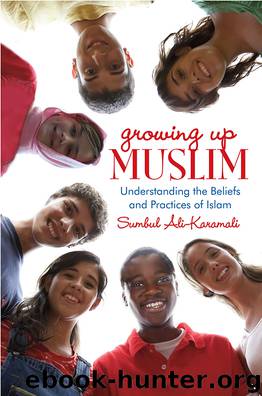Growing Up Muslim by Sumbul Ali-Karamali

Author:Sumbul Ali-Karamali [Ali-Karamali, Sumbul]
Language: eng
Format: epub
ISBN: 978-0-375-98340-5
Publisher: Random House Children's Books
Published: 2012-08-13T16:00:00+00:00
These verses do not specify exactly what people should wear but instead give general guidelines. Because these verses are not specific, Muslims have always debated their meaning, asking themselves: What clothing is modest and what isn’t, according to the Qur’an? What does the Qur’an mean by “decent to show”? What does the Qur’an mean by “head cloth”?
To understand these debates, it’s important to understand how people dressed in Arabia in the seventh century. At that time, women wore a piece of cloth that attached to the back of their heads and fell down their backs. Their tunics opened widely and often left their chests bare. Working women tended to be less covered than upper-class women, who sometimes wore veils as a sign of high status.
In their debates, the early Muslim scholars disagreed on many points, but they all agreed on some basics. They all agreed that both men and women had to cover their private parts, because it wouldn’t be “decent to show” them. They all agreed that Muslim women had to cover their chests, because the Qur’an said so. In our modern times, we generally agree with these principles, in that we consider it decent to cover our chests and private parts.
Using these principles as a basis for more discussion, the early Muslims agreed on a few more aspects of dress. They all agreed that men had to be covered at least from their knees to their navels. And they all agreed that women had to be covered from their chests down to their knees.
But beyond these agreed-upon basics, there was disagreement. Most Muslim scholars, but not all, said that women should cover their heads. Very few said that women should cover their faces. They all agreed that women’s chests had to be covered, but they disagreed on what exactly was meant by “chest”—did it start at the base of the neck, or lower down? Should a head scarf cover all the hair, or just some of it? Did the neck have to be covered? If hands, face, and feet could show, then did the definition of “hand” include the forearm, too? Did the definition of “feet” include the ankle? The calf? The scholars had different answers to these questions.3
Historically, Muslim women did not uniformly cover their hair. In early Islam, some women even prayed with their hair uncovered. Today, though, Muslim women do cover their hair while praying, whether or not they do so at other times.
The early Muslims considered several factors when interpreting the Qur’anic verses. Culture and hardship were two of those factors. In Arabian culture, as well as most cultures around the world at that time, people commonly wore head coverings of some sort; since it was the norm, it made sense that the early Muslims would have taken it for granted that people covered their hair. They took hardship into account, too, when they said that women who worked in the fields or did other physically difficult work did not have to cover themselves so much that their clothing would hamper them in their work.
Download
This site does not store any files on its server. We only index and link to content provided by other sites. Please contact the content providers to delete copyright contents if any and email us, we'll remove relevant links or contents immediately.
The Harvest: Taken by M.A. Church(1881)
Many Waters by Madeleine L'engle(1863)
The King James Study Bible by Thomas Nelson(1796)
Becoming Kareem by Kareem Abdul-Jabbar(1740)
A Prophet with Honor by William C. Martin(1682)
The Last Days of Jesus by Bill O'Reilly(1540)
Ethics 101 by John C. Maxwell(1512)
No God But God by Reza Aslan(1491)
The Boy on the Wooden Box by Leon Leyson(1478)
Chicken Soup for the Teenage Soul on Tough Stuff by Jack Canfield(1455)
Seasons of Splendour by Madhur Jaffrey(1450)
Chicken Soup for the Teenage Soul III by Jack Canfield(1324)
Devlok with Devdutt Pattanaik 2 by Devdutt Pattanaik(1235)
Burpo, Todd - Heaven Is for Real by Burpo Todd(1231)
King James Study Bible by Thomas Nelson(1212)
Great Horse Stories by Rebecca E. Ondov(1194)
Heaven Is for Real: A Little Boy's Astounding Story of His Trip to Heaven and Back by Todd Burpo(1191)
Words in the Dust by Trent Reedy(1150)
Kindertransport by Olga Levy Drucker(1133)
